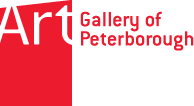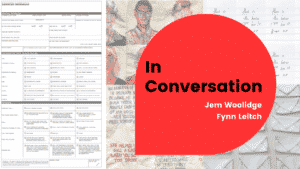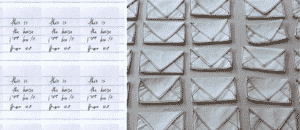Artists in Conversation: Jem Woolidge
Jem Woolidge in conversation with Fynn Leitch
Remote Interview: February 9, 2021
Jem Woolidge’s Application Form is one of the artworks featured in Presently, a juried exhibition that opened November 26, 2020. AGP Curator, Fynn Leitch, spoke with Woolidge about this work and their practice, which often pulls from the familiar, using textiles and text to create approachable, intimate, and often humourous work.
Fynn Leitch (FL): Tell us a little about yourself.
Jem Woolidge (JW): Hi! I’m Jem (they/them), I’m an interdisciplinary artist currently hosted in Kjipuktuk/Halifax, completing an undergrad at NSCAD University. I work with textiles and new media predominantly but also really have a soft spot for narrative comics and storytelling. I was raised in Nogojiwanong/Peterborough, and am very excited to have been invited to show work alongside so many artists I admire in Presently. Thanks for having me AGP!
FL: In a lot of your work, you start with something you’ve found. Often these are seemingly mundane things: overlooked vistas, banal forms, casual photographs. Through your work (embroidery, digital manipulation, painting) you bring forward additional layers and reveal what’s hidden. Can you share a bit about that aspect of your work?
Love Token (multiples), 2019, digital fabric print (left), machine sewing and muslin (right). The fabric printed notes were cut out and slipped into the envelopes.
JW: That’s very astute! I do feel like that’s something I’m drawn to – I think a lot of arts institutions encourage people to immediately go bigger, to base their work on huge lofty academic ideas and fill their artist’s statements with art jargon, which I can’t say I’m entirely absolved of – art jargon is pretty contagious. That being said, I find that things that are perceived as mundane are often a great entry point into complex subjects, and they tend to engage with people and meet them where they are. I used to feel really inadequate when engaging with some artworks where the meaning was obscured by opaque cultural references and big words, so I try to make the art I create come from a place of humour and familiarity.
I also think that the everyday, and things that we overlook as mundane or constant in our lives, are frequently indicative of larger systems or cultural impulses and trends. These things manifest in every aspect of our lives, not just the academic or exceptional. They exist whether we’re thinking about them or not, and sometimes it’s easier to see them through the lens of things we’re familiar with (at least it is for me). I also just like jokes and leisure activities and small funny things. I like working with comics as well for that reason. I made a comic this year about a Russian chess player whose website I stumbled on while doomscrolling, which, all things considered, is not a very interesting thing to have found, but actually ended up feeling really profound. I think those moments of seeing something normal or commonplace in your everyday life in a new light, where you realize just how interesting they are, is like an awakening for me every time. The comic’s narrative takes whomever is reading it along my train of thought and hopefully unfolds why I’m interested in those banal things.
Realizing that everything that exists around you is in conversation with the rest of the world, and that each person and every funny little thing you notice in your life has a story of how it got there; how it exists, and what it means to people makes every little thing feel significant and kind of wonderful. I think that’s really comforting; that almost everything contains meaning to someone, everything is based in care and meaning, and that care exists regardless of whether or not we notice it. It’s fun to try to dig into.
FL: Text and textiles feature prominently in your work. I’m wondering if you could tell me a bit about that, and why you return to them again and again?
JW: I do really love text and textiles. I think textiles communicate in a really soft, underpinned way, and obviously text is much more to-the-front. I also think textiles are a really comfortable spot for me, and I’ve been able to grow with my textile practice for the past (almost) decade. I’ve always loved handling string and working with fabric. Embroidery has this sense of immense care and time poured into it that I think really seeps into the work you make. Textiles feel like affective sponges to me. You can take half-done textile projects anywhere. When I was working on a large-scale embroidery piece called Harbour Front in high school, I used to embroider on the bus every day, and carry half done work everywhere with me. I think carrying around something you’re putting energy into allows it to kind of soak up all the places and moods you were travelling through. That’s why textiles have such a strong emotional charge to me. My friend Avery told me once that some crochet artists will leave a hidden mistake in their work so that their souls can escape; and that’s how I feel about textile work. It’s so intimate and time consuming and emotionally charged, and I love being in that space.
Harbour Front, 2017, hand embroidery on cotton
I also think a lot about how gendered textiles are; how often people associate them with womanhood in a really narrow and cis-normative sense. Being trans/non-binary and working in a heavily gendered medium has always been a point of tension for me, especially since I have no desire to make work about womanhood through textiles. There’s a really good article by Anj Fermor about transness and textiles called The Feminine, the Grotesque and the Reclaimed on the subject. That being said, I try to use textiles to talk about gender when I can. This tension makes using textile work to talk about embodied trans experiences more interesting to me.
In an embroidered tapestry project I finished last year called Devotional Portraits of Strangers, I wanted to explore how obsessed with strangers I had become, specifically how obsessed I was with what I imagined they thought of my gender. The project was comprised of two tapestries.
The portraits in the first tapestry are based on composite images of several people, designed to look familiar, but unplaceable; and the text on the second tapestry kind of contextualizes the faces. I like the way text can direct people to notice specific things in what they’re observing. Text is great for narrativizing what could otherwise feel random or insignificant, and I really enjoy working with it to give people a focal point. Text is intimate in its own way; it can be really up to interpretation, but, at the same time, it’s also intimate in the way it doesn’t really hide behind much. You can speak in metaphors to complicate and give nuance to the thing you’re saying; however, text is kind of naked because each word is technically supposed to have a specific meaning, but it doesn’t. There are so many different ways of communicating, and the language we use (consciously or unconsciously) exposes the way we interpret the world, how it’s built in our brains. When you describe something or express something through text, you’re describing yourself too. As I’m answering this question I’m realizing that maybe the common thread here is intimacy? Maybe I come back to these things again and again because they feel so intimate.
Left: Devotional Portraits of Strangers I, 2019, hand embroidery on cotton;
Right: Devotional Portraits of Strangers II, 2019, machine embroidery on cotton.
FL: Application Form explores the limits of identity as prescribed by bureaucratic formalities.” (Jemma Woolidge, 2020) Can you speak to the importance of inclusive bureaucracies? Are they even possible? In what ways can art act as a tool for change?
JW: That’s a big question! Frankly I don’t think there is one singular answer. I made this piece because I was frustrated with narrow gender marker options in forms. I’m a gender variant person, and out of touch gender options in forms of all kinds is an in-joke in my circles. Being told to choose between inapplicable options is a familiar experience for many Queer people, but it represents a much larger problem than just annoyance in having to decide whether “Mr.” “Mrs./Miss” or “Dr.” apply to you better in a job application. The relationship between notions of inclusion and bureaucracy are complex, and although academic/political/arts/etc. institutions can make small steps to be more inclusive (like not making the gender options on forms “man,” “woman,” and “prefer not to say” for example), those changes don’t equate to a structural re-imagination that would fundamentally shift the way those systems function.
There’s a significant difference between posturing in order to keep things ‘how they’ve always been’ in a bureaucratic institution by making incremental changes to policy, and giving people the tools and power to represent themselves accurately, and reshape the system to be better for everyone. That being said, I’m a white, abled, middle class settler, and I’m not qualified to advise on the specifics of how to do this – I am not trying to make an answer, but I would like to provoke questions. If you’re interested in learning more from someone much more qualified to speak on the subject, I would recommend looking into the work of artist, activist, and scholar Syrus Marcus Ware. His work is integral to my understanding of these subjects.
I personally believe that art can be a meaningful way to uncover and revisit the past, and to reimagine new futures. Art has a particular ability to interact with archives and unsettle the dominant stories we tell ourselves about our history, which has the potential to be really powerful when we can peel back the layers of the mythology of shared histories to see what’s really there. Through doing this, I think we can see what can be changed, and what’s keeping us from change.
FL: You’ve invited people to fill out copies of your “Application Form,” and share them with you for a larger project. Can you share a little about that, and how people can help you with it?
JW: Ideally, I’d like to use these forms to create some nonsensical informational charts – like demographic charts that arbitrarily connect the information I’ve gathered. One of the questions makes the person filling out the form choose between ‘being arrested for selling pills on the dark web,’ ‘becoming a reality star made popular by repeated accidental participation in pedestrian prank shows,’ and ‘moving to Reykjavik to be closer to your partner.’ With data from these forms, I might be able to make a pie chart connecting the fact that people who chose to move to Reykjavik also said Five Alive was their favourite fruit juice. This doesn’t really make any logical sense, but it might reveal how arbitrary ‘official’ forms and studies are. I’d love to have the opportunity to display the data through jumbles of charts and graphs on a wall, or in pamphlet form. I’m really obsessed with the aesthetics of corporate information, like what you’d imagine seeing if you walked into a corporate office during a presentation; but instead of business data, it’s just completely nonsensical correlations about how people who said their favourite sex position was cowgirl also selected that I’m annoying.
FL: Thank you so much Jem! It’s been wonderful talking to you and learning more about your practice.
You can download and fill out Jem Woolidge’s Application Form by clicking here. Once you’ve filled it in, email it to us at: gallery@agp.on.ca and we’ll send it along to the artist.





